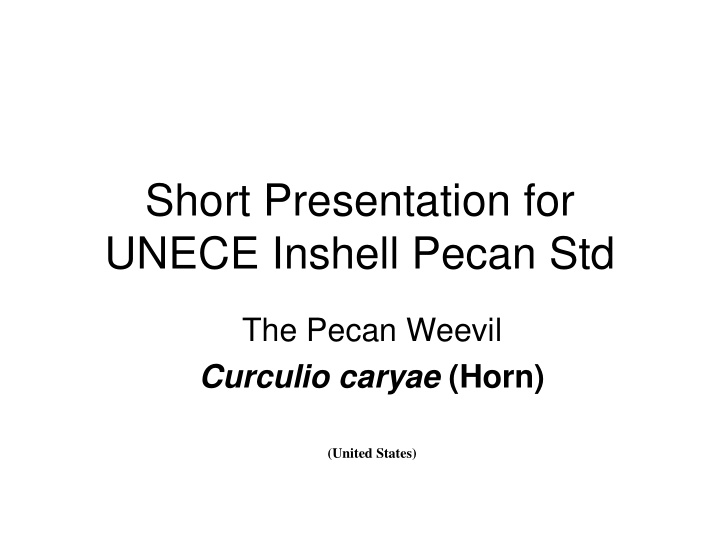



Short Presentation for UNECE Inshell Pecan Std The Pecan Weevil Curculio caryae (Horn) (United States)
• The adult is a light-brown or grayish beetle about 12 mm long, with a long beak. The beak of the female is longer than the body.
• Pecan weevils cause two types of damage. 1. Feeding during the water stage prior to shell hardening causes damaged nuts to drop
• Identification of damaged nuts: Damaged nuts can often be recognized by circular emergence holes through which the grubs exited the nuts
• Eggs of the pecan weevil are deposited in a pecan when the fruit is nearly hardened and contain well-developed kernels (dough state). • Larvae feed for about 35 days inside the nuts • Pecan weevils feed on the pecan kernel and chews a hole in the mature shell when through.
• Larve damage to the kernels that usually occurs after shell hardening. • Early maturing varieties are most susceptible to the weevils • Pecan weevil larve are not found in nuts with unhardened shells. • Infested nuts may be recognized by emergence holes about 1/8 inch (3 mm) in diameter through which the larve escaped (if there are no larve in the nuts), or by the adherence of husk to the shell
• Symptoms: • May begin feeding as adult weevils during the water or gel stage of pecan development, causing nuts to drop. Female weevils begin egg laying on average 6.5 days after emergence and can deposit an average of 4-4.5 eggs per pecan. Feeding damage by weevils during the gel stage can also cause "sticktights" where the shuck adheres to the nut or it can result in pitted (black spots) or moldy kernels near the feeding punctures. Larval feeding within the pecan causes complete destruction of the kernel.
• Identification of the presence of the Pecan Weevil. • Pecan trees have a natural drop of nuts in August, during this time producers observe the alert for adult pecan weevils emerging from soil under infested pecan trees.
• Dr. H C Ellis, Professor and Extension Entomologist, The University of Georgia, Department of Entomology, Tifton, GA 31793 Dr. D. L. Horton , Professor and Extension Entomologist, The University of Georgia, Department of Entomology, Athens, GA 30602,
Recommend
More recommend